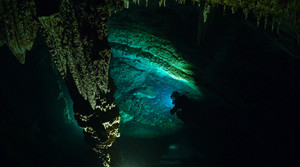 My parents are going to cringe when they read my book. They will have to put it down and take a deep breath. When my Mother first learned about the risks that were involved in my career of exploring and filming underwater caves, the color drained from her face. It terrifies her to imagine me squeezing through tiny spaces in submerged caves deep with the planet. One day she asked me, “are you afraid of dying?” I get that question all the time. Why would anyone want to lead a life with so many perceived risks?
My parents are going to cringe when they read my book. They will have to put it down and take a deep breath. When my Mother first learned about the risks that were involved in my career of exploring and filming underwater caves, the color drained from her face. It terrifies her to imagine me squeezing through tiny spaces in submerged caves deep with the planet. One day she asked me, “are you afraid of dying?” I get that question all the time. Why would anyone want to lead a life with so many perceived risks?
But, I genuinely believe that it is essential to take risks and embrace fear as a critical motivation to learn, discover and fulfill my highest potential. If I don’t embrace fear and learn how to work with it, then I might spend my life running away from everything that challenges me. I am not afraid to die. I am a lot more afraid of failing to live a fulfilling and active life.
Some call cave diving the world’s most dangerous sport, as well as the edgy frontier of earthbound scientific exploration and discovery. Even with modern equipment and training, an average of twenty people die each year in the dark catacombs of water-filled caves. As a cave diver, I swim through the veins of Mother Earth, exploring the shadowy recesses inside our planet. The foreboding doorways of underwater caves repel most people, but I am attracted to the constricted corridors, pressing my way through the blackness while relying on delicate technology for each sustaining breath. Within the darkness of my office, survival depends on a finite balance between fear and discovery. A bad decision at work could cost me my life.
My work involves doing things that nobody has done before; things that are termed impossible. But for me, the word impossible represents a challenge. To solve problems, I keep an open mind and understand that it is okay to fail. Failure gives us me a chance to experience what I call “discovery learning.” I might not know how to solve a problem right away, but if I apply a brave effort and am not successful, then I will ultimately know more than I did before I started. My second effort or even tenth effort might yield the ultimate solution.
It is also important to recognize when the risks are too high. In other words, I need to develop a good understanding of when to abort. In my line of work, that means I need to be able to get within a hair’s breadth of complete success and know when it is time to abandon the effort to ensure my survival. Before embarking on a dangerous quest, I look at risks and decide on the limits of my comfort and safety.
Parents choose how much risk they will permit their children to experience. I believe, it is far better to let a child get dirty and suffer a few scratches rather than protect them from everything they face. If they do not learn how to experience and assess risk themselves, then they will always expect somebody to take care of them. They need the feedback of a little pain to make better choices the next time. Experiencing the consequences of taking risks helps all of us form boundaries for future explorations.
One could say that Thomas Edison failed in his efforts to invent the light bulb. He failed a lot. The public shunned him for wasting his time working on a goal that was pure fantasy, yet he eventually prevailed. With each failure, he learned more and invented the light bulb that is ubiquitous in our lives today.
United States President F. D. Roosevelt said, “the only thing we have to fear is fear itself,” yet our society and politics often hijack our sense of comfort. An entire generation is retreating, preferring to learn everything from the Internet and television instead of leading an experiential life. An experiential life, full of risks, bumps, and bruises is filled with discovery, uncertainty, learning, and growth.
In 2001, I was the first person to cave dive inside tunnels within icebergs in Antarctica. There were many risks, some even unpredictable. Was I afraid of dying? Perhaps for a moment. But when I assessed the risks and rewards, organized and planned my dive, I concluded that my goals were achievable. I plunged into the freezing water to dive into history. I’m sure the film of that dive terrified my Mother, but I know she is also proud that I embraced my fear and chose to act.
If you want to read more about risk assessment and my daring explorations, please pre-order a copy of my memoir Into The Planet, to be released on August 27, 2019, online and through booksellers everywhere.
